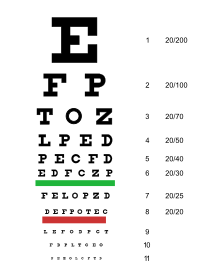| Childhood blindness | |
|---|---|
 | |
| Snellen chart used to determine visual acuity | |
| Causes | Genetic disorder, Infection[1] |
| Diagnostic method | Pupillary reflex(among others)[2] |
| Prevention | Vitamin A supplement |
Childhood blindness is an important contribution to the national prevalence of the disability of blindness.[3] Blindness in children can be defined as a visual acuity of <3/60 in the eye with better vision of a child under 16 years of age.[4] This generally means that the child cannot see an object 10 feet (about 3 meters) away, that another child could see if it was 200 feet (about 60 meters) away.[5]
- ^ "Eye Problems in Babies. Baby Eye Problems. Patient". patient.info. Archived from the original on 2 January 2018. Retrieved 2 January 2018.
- ^ Gogate, Parikshit; Gilbert, Clare; Zin, Andrea (2011). "Severe Visual Impairment and Blindness in Infants: Causes and Opportunities for Control". Middle East African Journal of Ophthalmology. 18 (2): 109–114. doi:10.4103/0974-9233.80698. ISSN 0974-9233. PMC 3119278. PMID 21731320.
- ^ GLOBAL DATA ON VISUAL IMPAIRMENTS 2010 (PDF). WHO. 2012. p. 6. Archived (PDF) from the original on 2015-03-31. Retrieved 2020-10-04.
- ^ Mabey, David; Gill, Geoffrey; Weber, Martin W.; Whitty, Christopher J. M. (2013-01-17). Principles of Medicine in Africa. Cambridge University Press. ISBN 9781107002517. Archived from the original on 2023-11-21. Retrieved 2020-11-09.
- ^ "The criteria for certification". RNIB - See differently. 19 February 2014. Archived from the original on 23 September 2022. Retrieved 5 June 2020.